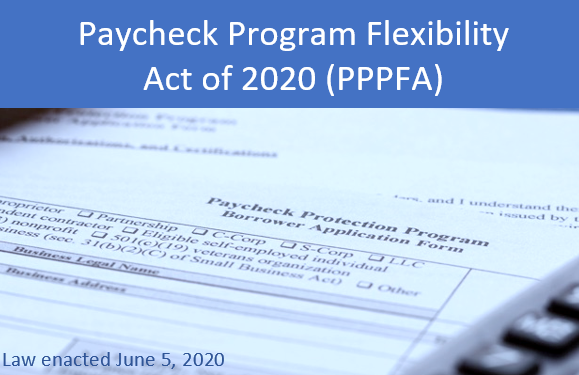Relaxed Rules for Paycheck Protection Forgiveness

Through a joint effort by both chambers of Congress, the Paycheck Program Flexibility Act of 2020 (PPPFA) was signed into law by President Trump on June 5, 2020. This Act aims to give borrowers more time and flexibility in the forgiveness piece of the Paycheck Protection Program (PPP).
The key takeaways are as follows:
• The PPPFA extends the time period to use the PPP funds from 8 weeks to the earlier of 24 weeks or 12/31/20 for all new borrowers (loan entered into on June 5, 2020 or later) and existing borrowers. Existing borrowers may choose to use the 8 weeks, if preferred.
• The PPPFA changes the payroll expenditure requirement from 75% of the PPP loan to 60% of the PPP loan.
– This change initially made this 60% a cliff for forgiveness in that if the borrower did not use 60% of the PPP loan for eligible payroll expenses then the borrower was not eligible for forgiveness of any of the PPP loan. A joint announcement was made on June 8, 2020 by the Treasury Department and the SBA regarding changes to the 60% “cliff rule” for loan forgiveness.
– Regarding the June 8, 2020 announcement, partial forgiveness is available if a borrower spends less than 60% of its PPP loan on eligible payroll expenses. There is a calculation to determine the partial forgiveness subject to at least 60% of the loan forgiveness amount having been used for eligible payroll expenses.
• The PPPFA makes changes and adds to the safe harbor rules regarding the rehire of employees for the head count and wages portions of the loan forgiveness process.
– The deadline to rehire workers is pushed from June 30, 2020 to December 31, 2020. Employers now have until December 31, 2020 to rehire employees to have the employees and their wages count toward forgiveness.
– Employers can still receive loan forgiveness if the employer is unable to rehire an individual who was an employee of the business on or before February 15.
– Employers can receive loan forgiveness if able to demonstrate an inability to hire similarly qualified employees on or before December 31, 2020
– Employers can receive loan forgiveness if able to demonstrate an inability to return to the same level of business activity as such business was operating at prior to February 15, 2020.
• The PPPFA extends the repayment term for the PPP loans from 2 years to 5 years for those loans put into place on June 5, 2020 or after. The option to extend the repayment term is available for existing borrowers but must be mutually agreed upon by the borrower and the lender.
• The PPPFA extends the payment deferment period from six months after the end of the covered period to the date the SBA sends the borrower’s loan forgiveness amount to the lender. If the borrower does not apply for forgiveness, the deferral period lasts until 10 months after the end of the covered period according to guidance issued by the SBA June 8, 2020.
• The PPPFA allows deferment of the employer’s payroll taxes for Social Security for PPP loan recipients.
• The June 30, 2020 date remains in place as the last day for a PPP loan application to be approved. This was NOT changed by the PPPFA.
We anticipate more updates to the PPP loan forgiveness process and will continue to endeavor in our attempts to provide current updates to you along the way.
Please follow Byrne Zizzi CPA on LinkedIn and Facebook for tax updates
